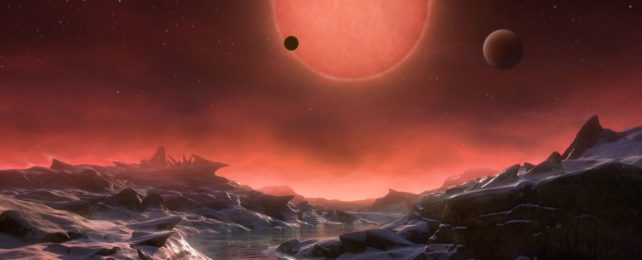The Milky Way galaxy could be a much wetter place than we knew.
A new analysis of exoplanets orbiting red dwarf stars suggests that we may have been missing a population of "water worlds" – soggy planets whose composition consists of up to 50 percent water.
Not all of these worlds will be covered in a global liquid ocean; scientists expect that, for many of them, the water will be bound up in hydrated minerals. However, the finding may have implications for our search for life outside the Solar System.
"It was a surprise to see evidence for so many water worlds orbiting the most common type of star in the galaxy," says astronomer Rafael Luque of the University of Chicago.
"It has enormous consequences for the search for habitable planets."
Although we can't see a single red dwarf with the naked eye, these stars are incredibly numerous. Small, cool, and dim, red dwarfs are, at maximum, only about half the mass of the Sun.
Their low fusion rate gives them the largest longevity of all stars; at 13.8 billion years old, the Universe isn't old enough for a red dwarf star to have lived out its entire, estimated 100 billion-year lifespan.
An estimated 73 percent of the stellar population of the Milky Way consists of red dwarf stars. Just have a think about that for a moment. When you go out stargazing, in a cool field or atop the flatbed of a truck in the desert on a warm summer night, you can't even see most of the stars in the sky.
Because they're so dim and red, finding exoplanets in orbit around red dwarfs is difficult. Just a small percentage of the 5,084 confirmed exoplanets at time of writing have been found around red dwarf stars.
However, our instruments are growing ever more sophisticated – enough so that scientists have been able to characterize dozens of small worlds orbiting these small stars.
There are two main signals scientists look at to characterize an exoplanet. The first is a regular faint dimming of starlight as the orbiting exoplanet passes between us and the star.
The second is a minute lengthening and shortening of wavelengths of light from the star, as the orbiting exoplanet exerts a faint gravitational pull.
If you have these measurements, and know how far away the star is (and therefore how much light it emits), you can measure the radius and mass of the exoplanet – two characteristics from which astronomers can derive the density of an exoplanet.
This density can be used to infer the exoplanet's composition. A low density is likely to mean an exoplanet with a lot of atmosphere, like a gas giant. A high density is likely to mean a rocky world, like Earth, Venus, or Mars.
Luque and his colleague, astronomer Enric Pallé of the Institute of Astrophysics of the Canary Islands and the University of La Laguna in Spain, conducted a density study of 43 exoplanets orbiting red dwarf stars.
Typically, these exoplanets have been separated into two categories: rocky exoplanets and gassy ones with thick atmospheres. But Luque and Pallé saw a curious, third category emerging: exoplanets that are too dense to be gassy, but not quite dense enough to be purely rocky, either.
Their conclusion was that the rock composition of these middle-range exoplanets was mixed in with something lighter… like water, perhaps. But, while it's tempting to imagine a world teeming with tempestuous seas, these planets are too close to their stars for liquid water on their surfaces.
If their water was on the surface, it would puff up their atmospheres, making them even larger in diameter, and lower in density.
"But we don't see that in the samples," Luque says. "That suggests the water is not in the form of surface ocean."
Instead, these worlds could look something like another object in the Solar System – Jupiter's moon Ganymede, which is roughly half rock and half water, with the water hidden beneath a rocky, icy shell. Or they could be a bit like the Moon (although significantly wetter), which has water molecules bound up in glass and minerals.
However these worlds have retained their water, if the team's conclusions are correct, the discovery suggests that these worlds could not have formed where they did. Instead, they would have had to have formed farther from their stars, from rock and ice, and migrated inwards to their current positions.
However, without further evidence, it's impossible at this stage to make a ruling in favor of this model, one way or another.
"Leaving aside this possibility for discovering alien life-forms," writes astronomer Johanna Teske of the Carnegie Institution for Science in a related Perspective, "measuring the compositional diversity of planets around red dwarf stars – the most common type of star in the Milky Way – is important for piecing together the complex puzzle of small planets' formation and evolution."
The research has been published in Science.
